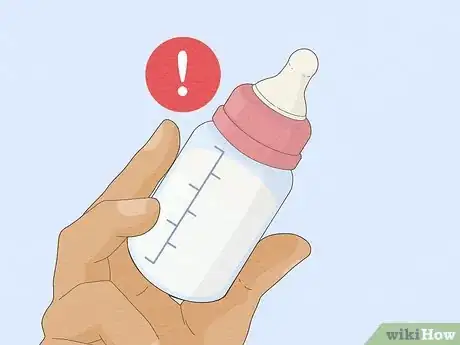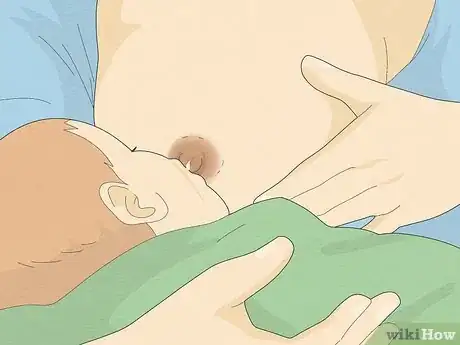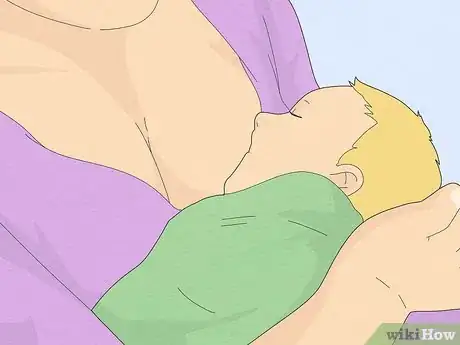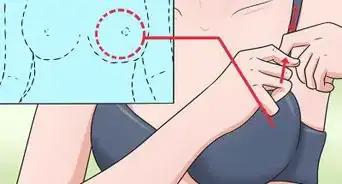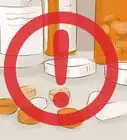This article was co-authored by Joel Warsh, MD and by wikiHow staff writer, Jessica Gibson. Dr. Joel Warsh is a board certified Pediatrician and the Owner & Founder of Integrative Pediatrics and Medicine in Los Angeles, California. With over a decade of experience, Dr. Warsh specializes in holistic and integrative medicine. He holds a Bachelor’s degree in Kinesiology and Health Sciences, a Master’s degree in Epidemiology and Community Health, and a Doctor of Medicine (MD) from Thomas Jefferson Medical College, where he was elected president of the Jefferson Pediatric Society. Dr. Warsh then completed his Pediatric Residency at Children’s Hospital of Los Angeles (CHLA), where he received the George Donnell Society Research Fellow.
There are 7 references cited in this article, which can be found at the bottom of the page.
This article has been viewed 14,999 times.
You've heard the phrase nipple confusion, but flow preference is probably a more accurate term to describe a fussy baby's frustration with breastfeeding. If you introduced pacifiers or a bottle before your baby mastered breastfeeding, they might favor the fast flow and ease of using a bottle. When you try to put them back on the breast, they struggle because it takes more effort to get the milk. Fortunately, you can reconnect and re-establish breastfeeding so your baby thrives.
Steps
Getting the Baby Back to the Breast
-
1Reduce the number of times you offer a pacifier or bottle. There's disagreement about whether you should offer pacifiers or bottles to a baby that prefers the bottle to the breast. You may want to feed your baby a bottle once or twice a day instead of for every feed.[1]
- Offer the breast instead of a pacifier whenever it seems like the baby wants to suck.
Tip: To prevent nipple confusion, give your newborn 2 to 4 weeks to master breastfeeding before introducing a pacifier or bottle.[2]
-
2Watch your baby for hunger cues and try to breastfeed before your baby gets upset. If your baby is already really hungry, they're probably upset, which will make breastfeeding more challenging. Try to breastfeed your baby as soon as you notice any of these common hunger cues:[3]
- Sucking their fist or fingers
- Waking from sleep
- Fussing but not crying
- Waving their arms
Advertisement -
3Express a little milk before offering the breast to your baby. If your baby is used to the fast and immediate flow of milk that comes from a bottle, they may get frustrated at the breast. Manually express or use a pump so your milk lets down. Then, let your baby latch on so they're immediately rewarded with breast milk.[4]
- If you can, try manually expressing milk directly into your baby's mouth so they're eager to nurse.
-
4Adjust your breastfeeding positions. To make it easier for your baby to nurse, lie back with your baby on you so you're tummy to tummy. Your baby will feel supported and close with you so they can feed easily. If it's more comfortable, try the cradle hold where you lay the baby horizontally in front of you while supporting their body.[5]
- Play around with different breastfeeding positions until you find the ones that your baby prefers.
-
5Check your baby's latch to ensure they're sucking effectively. Your baby's mouth should be wide open when you bring your baby to your breast so they're able to take more of the areola in their mouth. If the baby's latch is good, you'll soon hear swallowing.[6]
- If breastfeeding is painful, take the baby off of your breast and try to latch again.
Improving Your Breastfeeding Relationship
-
1Spend more time skin to skin with your baby. Your baby will feel more comforted and relaxed when they're in direct contact with you. Plan on snuggling with your baby for a few days to encourage your baby to breastfeed frequently. If you sleep near your baby, keep your breasts uncovered so they're more likely to breastfeed.[7]
- Consider wearing your baby in a sling during the day so they're constantly connected with you. This feeling of closeness can relax them so they're calmer during nursing sessions.
-
2Relax and stay calm when it's time to nurse. Your baby may feel anxious if you are stressed about breastfeeding. Take time before the nursing session to relax and unwind. This can also make your milk letdown easier. To help yourself feel calm, you could:[8]
- Practice deep breathing
- Meditate
- Play soothing music
- Breastfeed in a quiet, dim room
-
3Be patient and give your baby time to re-establish breastfeeding. Your baby won't change their feeding preferences overnight, so give them at least 1 or 2 days to become comfortable with breastfeeding again. Remind yourself that your baby is developing breastfeeding skills so be patient with them.[9]
Tip: Ask for extra help from family or friends so you can focus on feeding your baby. For example, see if a relative can come over and watch your older children or bring your family a meal.
-
4Praise your baby every time they show improvement. Although your baby is quite young, they can follow your facial expressions when you're close to them. If your baby has a good latch on or attempts to breastfeed, say, "Good baby!" and smile widely.[10]
- Be consistent and give verbal praise frequently as your baby attempts to breastfeed.
-
5Reach out for support if your baby still fusses after 3 or 4 days. If you've spent several days trying to improve your breastfeeding relationship but your baby is still struggling, don't hesitate to contact a lactation consultant.[11] They can offer you specialized support, show you different breastfeeding positions, and determine if your baby is getting enough nutrition.[12]
- Ask your hospital, birth center, or midwife if a lactation consultant is available to work with you.
Expert Q&A
Did you know you can get expert answers for this article?
Unlock expert answers by supporting wikiHow
-
QuestionHow do I get help if my baby has nipple confusion?
 Joel Warsh, MDDr. Joel Warsh is a board certified Pediatrician and the Owner & Founder of Integrative Pediatrics and Medicine in Los Angeles, California. With over a decade of experience, Dr. Warsh specializes in holistic and integrative medicine. He holds a Bachelor’s degree in Kinesiology and Health Sciences, a Master’s degree in Epidemiology and Community Health, and a Doctor of Medicine (MD) from Thomas Jefferson Medical College, where he was elected president of the Jefferson Pediatric Society. Dr. Warsh then completed his Pediatric Residency at Children’s Hospital of Los Angeles (CHLA), where he received the George Donnell Society Research Fellow.
Joel Warsh, MDDr. Joel Warsh is a board certified Pediatrician and the Owner & Founder of Integrative Pediatrics and Medicine in Los Angeles, California. With over a decade of experience, Dr. Warsh specializes in holistic and integrative medicine. He holds a Bachelor’s degree in Kinesiology and Health Sciences, a Master’s degree in Epidemiology and Community Health, and a Doctor of Medicine (MD) from Thomas Jefferson Medical College, where he was elected president of the Jefferson Pediatric Society. Dr. Warsh then completed his Pediatric Residency at Children’s Hospital of Los Angeles (CHLA), where he received the George Donnell Society Research Fellow.
Board Certified Pediatrician
-
QuestionWhat is the best way to avoid nipple confusion?
 Joel Warsh, MDDr. Joel Warsh is a board certified Pediatrician and the Owner & Founder of Integrative Pediatrics and Medicine in Los Angeles, California. With over a decade of experience, Dr. Warsh specializes in holistic and integrative medicine. He holds a Bachelor’s degree in Kinesiology and Health Sciences, a Master’s degree in Epidemiology and Community Health, and a Doctor of Medicine (MD) from Thomas Jefferson Medical College, where he was elected president of the Jefferson Pediatric Society. Dr. Warsh then completed his Pediatric Residency at Children’s Hospital of Los Angeles (CHLA), where he received the George Donnell Society Research Fellow.
Joel Warsh, MDDr. Joel Warsh is a board certified Pediatrician and the Owner & Founder of Integrative Pediatrics and Medicine in Los Angeles, California. With over a decade of experience, Dr. Warsh specializes in holistic and integrative medicine. He holds a Bachelor’s degree in Kinesiology and Health Sciences, a Master’s degree in Epidemiology and Community Health, and a Doctor of Medicine (MD) from Thomas Jefferson Medical College, where he was elected president of the Jefferson Pediatric Society. Dr. Warsh then completed his Pediatric Residency at Children’s Hospital of Los Angeles (CHLA), where he received the George Donnell Society Research Fellow.
Board Certified Pediatrician
References
- ↑ https://sciencebasedmedicine.org/separating-fact-from-fiction-in-the-not-so-normal-newborn-nursery-pacifiers-and-nipple-confusion/
- ↑ Joel Warsh, MD. Board Certified Pediatrician. Expert Interview. 2 February 2021.
- ↑ https://www.llli.org/breastfeeding-info/nipple-confusion/
- ↑ https://www.llli.org/breastfeeding-info/nipple-confusion/
- ↑ https://www.llli.org/breastfeeding-info/nipple-confusion/
- ↑ https://americanpregnancy.org/breastfeeding/latch/
- ↑ https://www.breastfeeding-problems.com/skin-to-skin-benefits.html
- ↑ https://nursingthebaby.com/fix-nipple-confusion/
- ↑ https://www.laleche.org.uk/nipple-confusion/
- ↑ https://www.llli.org/breastfeeding-info/nipple-confusion/
- ↑ Joel Warsh, MD. Board Certified Pediatrician. Expert Interview. 2 February 2021.
- ↑ https://www.laleche.org.uk/nipple-confusion/
